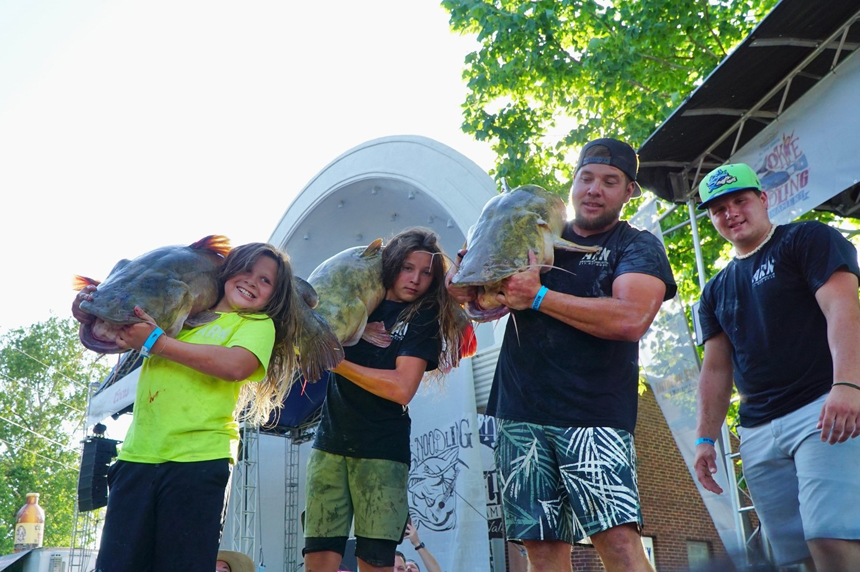For 25 of his 29 years, Oklahoma native Roger Simpson has been sticking his arm into holes in riverbanks, hoping he’ll grab the lip of a catfish that he can yank out of the water. The only difference between his first expedition and his most recent is that, these days, his 8-year-old daughter Sophia likes to join him.
Their partially underwater adventures may sound strange, but in the American South, such activities are as well-known as hunting, fishing, or playing football. Simpson and his daughter are noodlers, folks who catch catfish with their bare hands.
“I’ve been going with my dad and grandpa since they was pulling me around on a float tube,” Simpson, a resident of Wewoka, says. “I’ve been doing it since I was probably 5, 6 years old. It’s just natural instincts. Either you got it or you don’t.”
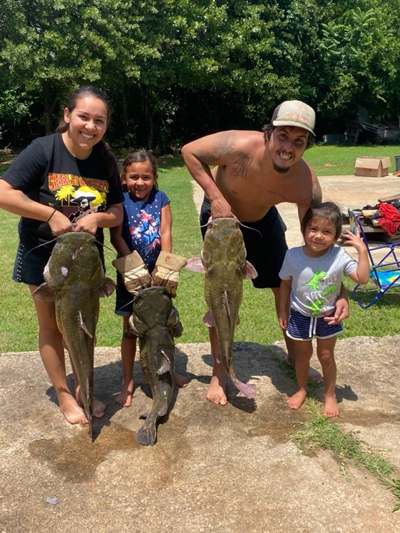
Using Your Noodle
The earliest historical accounts of noodling date to the late 1700s and describe how Native Americans caught catfish barehanded. The practice wasn’t originally called noodling, of course, and noodlers have their own theories about how the name came to be. Some suggest that catfish are as slippery as noodles; others say it’s because people wiggle their fingers around to catch fish, making their fingers look like noodles. Noodling has also been called grabbling, tickling, and stumping.
No matter the name, the basics of noodling remain the same. The summer months are prime times for catching. Catfish are laying eggs and growing, and noodlers are trying to find them.
To catch catfish, noodlers look for brush that covers parts of river channels, rocks that form underwater ledges, and submerged holes in riverbanks. All are places where fish nest. Noodlers slowly stick their arms into the crevices and try to latch onto a fish’s lip so they can pull the fish to the surface.
That’s not always an easy task. Catfish can weigh anywhere from 20 to 60 pounds, and they can live for 10 years or longer depending on their health and environment. That’s why noodling takes years of practice and skill. Thick skin helps, too, because catfish often cut people’s hands and draw blood. “I’ve seen 30-pound fish whip 200-pound grown men that work out every day,” Simpson says. “You’ve just got to know what you’re doing.”
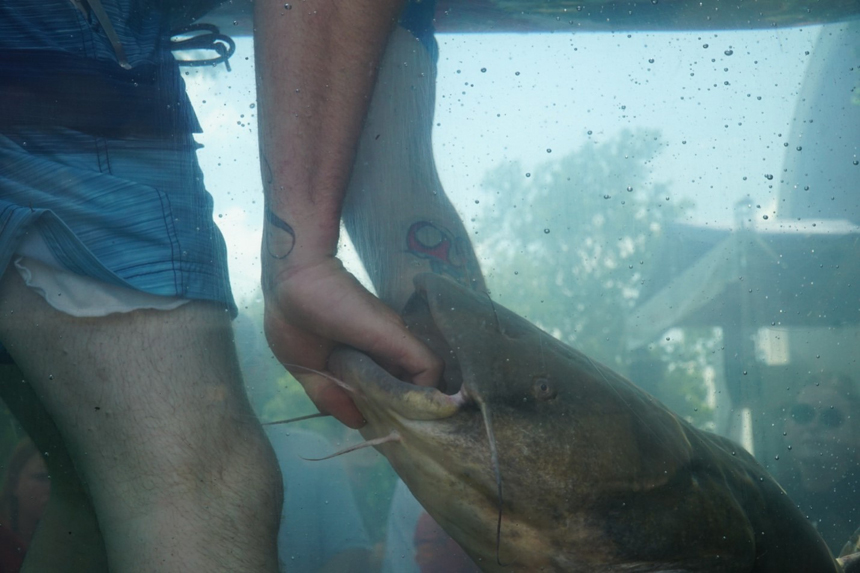
For most noodlers, however, reward outweighs risk. Fort Cobb, Oklahoma, resident Kyler Weidenmaier started noodling three years ago thanks to his cousin. Like other noodlers, he gets a thrill out of getting ahold of a catfish, a sensation most noodlers call “getting bit.” “It’s really hard to describe,” he says. “[The catfish] just crushes your hand. It feels like sandpaper. … I had a big cut across my chest last year from one catching me with his fin, and I’ve got a chunk taken out of my hand right now.”
Injuries didn’t keep him from participating in the single most famous noodling event of the year – the same one that propelled the sport to stardom.
Rising to Fame

Though noodling has been around for ages, it wasn’t always widely known. But once a 2001
documentary called Okie Noodling was broadcast, noodling suddenly became a source of intrigue for people from coast to coast, in small towns and big cities alike. The documentary was also responsible for the creation of the world’s largest noodling tournament: the Okie Noodling Tournament in Pauls Valley, Oklahoma. It takes place annually in June during Father’s Day weekend.
More than 20 years after its inception, the tournament still draws in noodlers and spectators from Oklahoma, Texas, Kansas, and other states. Hundreds of people attend the annual event, cheering as noodlers bring their big catches on stage to show them off. There’s even a tank mounted on a trailer where tournament-goers can noodle a catfish of their own.
The tournament is where Weidenmaier and his fellow noodlers were on June 18, lining up their trucks in the hot summer sun to weigh in fish before the 6 p.m. deadline that Saturday. Noodlers sign up early to participate, and they have a 36-hour period before the end of the competition in which they can catch fish. After all fish have been weighed and displayed, winners receive cash prizes.
It’s fun, but folks mean business – literally. Vendors riding the waves of noodling’s popularity come to the event in droves to pedal noodling-themed merchandise, including fishing-themed hats and shirts with sayings like “Bite Me,” “Kiss My Bass,” and “Eat, Sleep, Fish.” Representatives from the Tulsa Drillers minor league baseball team showed up to market the team’s noodling-themed weekend in August. For a few days, the team will rebrand itself as the Tulsa Noodlers, donning Noodlers jerseys and hats on the field. Fans will be able to chow down on catfish at games, too. The team first rebranded in 2021.
“A lot of other minor league teams come up with local food identities or different things like that to kind of have some fun at the ballpark to tie in with fans,” says Alex Kossakoski, the team’s director of promotions and merchandise. “We were trying to come up with something, and I don’t know if we saw an article or something like that, but we were like, ‘What about noodling?’ That’s so Oklahoma.”
Giving It a Shot
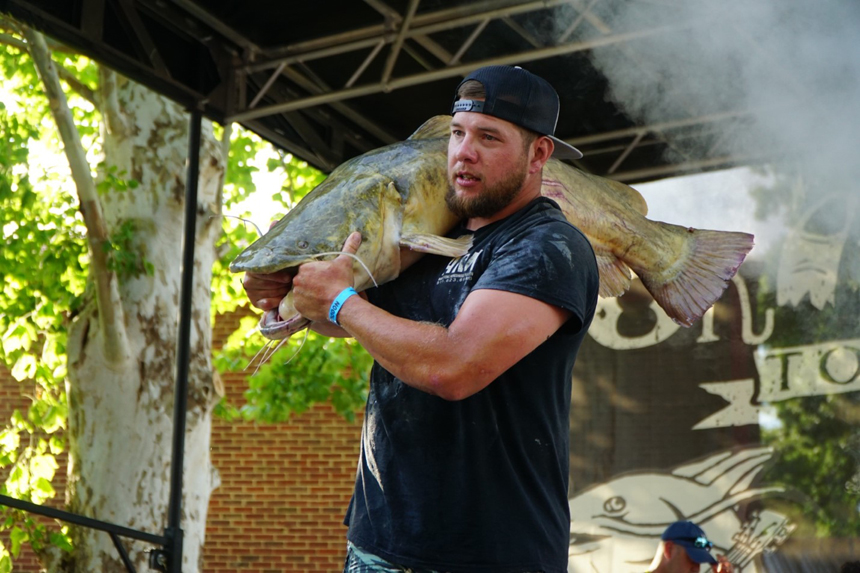
If noodling tickles your fancy, you can give it a try. Some longtime noodlers have become guides, taking people on expeditions to try their hands (and fingers) at catching a catfish.
Nathan Williams and his family own the Adrenaline Rush Noodling Guide Service in Shawnee, Oklahoma. Williams, who was featured on the Animal Planet TV documentary series River Monsters, has taken hundreds of people on tours. It all started when a friend of his asked to go on a guided expedition, and from there, a business blossomed. He still finds joy in seeing his clients catch a catfish.
“They’re always excited,” Williams says. “Any flathead over 20 pounds looks like a monster. So, everybody just gets so excited about how big a fish they get, and I like seeing that. They really feel proud of themselves.”
The catfish-curious can learn more about his guided expeditions on the noodling service’s Facebook page, and they can watch videos of tours by visiting the service’s YouTube channel. When Williams is overbooked on tours, his son Jayce will take on other groups. Their teamwork highlights how noodling is more than just a fun pastime. It’s a family affair.
A Father’s Day Gift
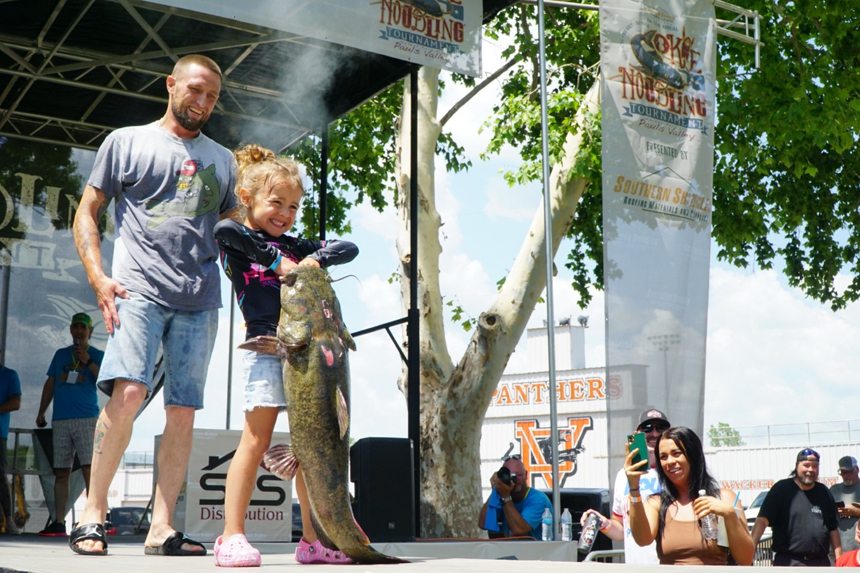
Father’s Day was just hours away when Lawton, Oklahoma, resident Jesse Dalton pulled up to the noodling tournament. His Father’s Day gift came a day early: His daughter Kennedy joined him at the noodling tournament for the first time.
“I’ve been waiting for this moment for five years since she the day she was born,” Jesse says. “I’ve won this tournament before, so I’ve been waiting for her to get old enough to be able to grab one. This year, two weeks ago, she caught her first fish. She really got in there and grabbed it by the mouth.”
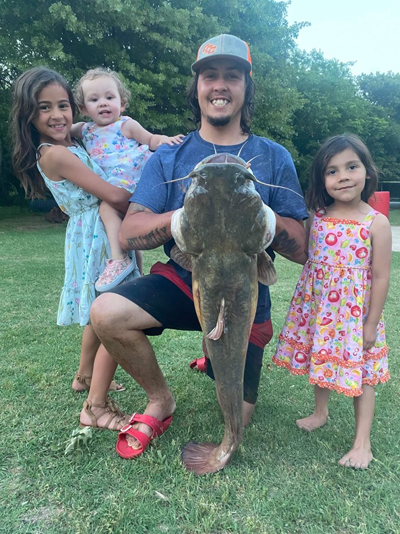
She caught one the morning of the tournament, carrying the catch on stage and receiving thunderous applause from the audience. A smile beamed across her face. Her dad smiled, too.
“I couldn’t have asked for anything more,” Jesse says. “I’ll remember this, and she’ll remember this, for the rest of her life.”
Simpson, the Wewoka noodler, can relate. In all the years he spent fishing with his grandpa and father, he’s learned about the special bonds the activity can help families form. One thing he’s learned is to release large, old fish back into the wild. “Out of respect for the fish, really,” he says. “They’re old. They’re older than me, man. They’re dinosaurs. They’ve been there a lot longer than I’ve been alive.”
His family taught him the values of respecting the old catfish and letting them live, and he’ll pass that lesson on to his daughter. Someday, Sophia just might just noodle up one of those old catfish herself.
Featured image: The Williams family of Shawnee, Oklahoma, poses for a photo on stage during the Okie Noodling Tournament in Pauls Valley on June 18. (Photo courtesy Jordan Green)
Become a Saturday Evening Post member and enjoy unlimited access. Subscribe now
